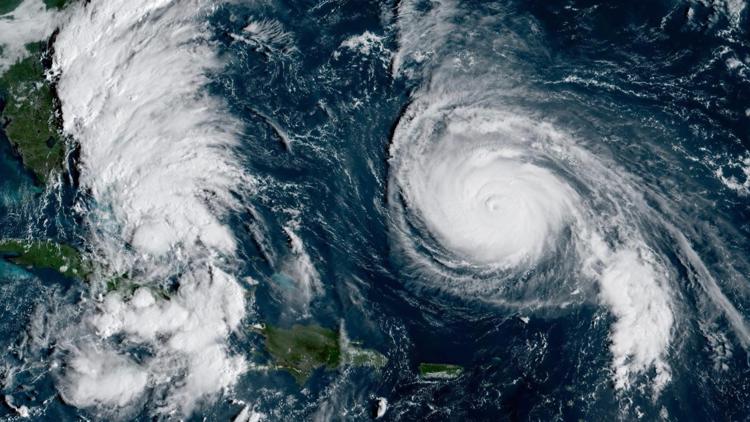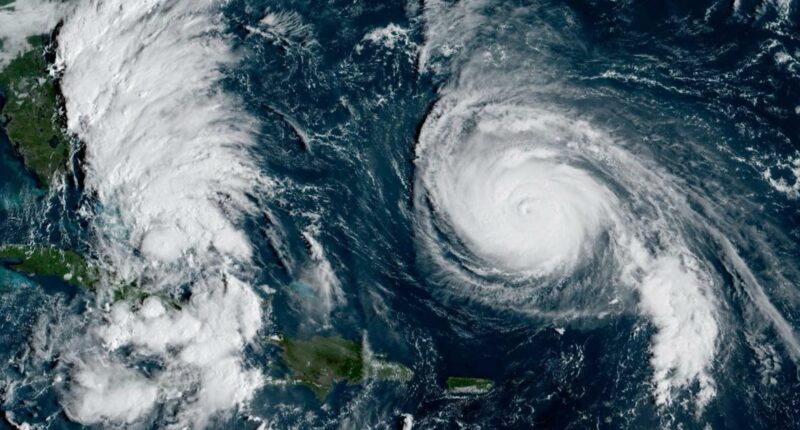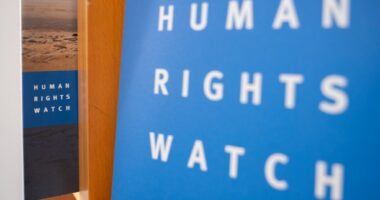Share this @internewscast.com

Power outages were reported in certain regions, prompting authorities to close government offices on the impacted islands and to issue mandatory evacuation orders for several islands.
SAN JUAN, Puerto Rico — On Monday, the Bahamas authorities shut down most schools as Tropical Storm Imelda unleashed heavy rain in the northern Caribbean, impacting Cuba where two fatalities were reported due to the storm.
The storm was situated approximately 120 miles (190 kilometers) north of Great Abaco Island in the Bahamas, an area still recuperating from Hurricane Dorian, which struck as a catastrophic Category 5 hurricane in 2019.
Imelda was characterized by maximum sustained winds of 65 mph (100 kph) and was advancing north at 9 mph (15 kph). The National Hurricane Center in Miami forecasted that the storm would escalate into a hurricane by Tuesday morning and then veer out into the open ocean.
A tropical storm warning was in place for sections of the extreme northwestern Bahamas, covering Great Abaco, Grand Bahama Island, and nearby keys. Power outages affected several areas, leading authorities to close government offices on affected islands and issue mandatory evacuations on some islands over the weekend.
2 deaths and evacuations across Cuba
Late on Monday, Cuban Prime Minister Manuel Marrero reported that two individuals died following Imelda’s impact on eastern Cuba. Via his X account, Marrero mentioned the two deaths occurred in Santiago de Cuba province, though he did not provide further details.
Earlier, state media reported that 60-year-old Luis Mario Pérez Coiterio had died in Santiago de Cuba following landslides in that area.
In Santiago de Cuba, flooding and landslides cut off 17 communities, according to the official newspaper Granma. More than 24,000 people live in those communities.
In Guantánamo, another impacted province, more than 18,000 people have been evacuated, according to reports from the state-run Caribe television channel.
Imelda was expected to drop 4 to 8 inches (10 to 20 centimeters) of rain across the northwest Bahamas through Tuesday, and 2 to 4 inches (5 to 10 centimeters) across eastern Cuba.
Humberto roars in open waters
Meanwhile, Hurricane Humberto, a Category 4 storm, churned in open waters nearby, which forecasters said would cause Imelda to abruptly turn to the east-northeast, away from the southeastern United States coast.
“This is really what’s going to be saving the United States from really seeing catastrophic rainfall,” said Alex DaSilva, lead hurricane expert for AccuWeather, a private U.S. weather forecasting company.
DaSilva said the two storms would draw closer and start rotating counterclockwise around each other in what’s known as the Fujiwhara effect.
“It’s a very rare phenomenon overall in the Atlantic basin,” he said.
Humberto had maximum sustained winds of 140 mph (220 kph). It was located about 295 miles (475 kilometers) southwest of Bermuda, moving north-northwest at 13 mph (20 kph). A hurricane watch was in effect for Bermuda.
“This is going to be no threat to the United States,” DaSilva said.
The Carolinas brace for Imelda’s rains
Moisture from Imelda was expected to move up the Carolinas, with heavy rain forecast through Tuesday morning. The heaviest rains will be limited to the coastline, from Charleston in South Carolina to Wilmington in North Carolina, while Charlotte and Raleigh might receive only 1 to 2 inches (3 to 5 centimeters) of rain, he said.
The Carolinas might see wind gusts of 40 mph, but only along the coastline, DaSilva said, as he warned of dangerous surf and heavy rip currents all week.
South Carolina Gov. Henry McMaster said authorities were prepositioning search and rescue crews over the weekend.
In North Carolina, Gov. Josh Stein declared a state of emergency even before Imelda formed, while authorities on Tybee Island off the coast of Georgia handed out free sandbags to residents.
Even though Imelda was not making landfall in Florida, its impact was still felt.
At the Loggerhead Marinelife Center in Juno Beach, crews found a couple of turtle hatchlings that rough surf had tossed ashore.
“We actually had two washbacks come in over the weekend,” said Justin Perrault, the center’s vice president of research. “We may get more as the day goes along.”
He said typically beachgoers will see a hatchling resting in the seaweed and call the center for help.
Farther south in Fort Lauderdale, Florida, Carl Alexandre exercised at the beach on Monday. He said he was grateful the storm was not heading toward South Florida, but that he would pray for those in the Bahamas.
“It’s great that we’re not having one as of right now,” Alexandre said. “And now we get to run in the Florida sun.”
‘A double whammy for Bermuda’
Authorities in Bermuda hoped neither of the two storms would be a direct hit later in the week, though they were forecast to, at least, come close, with Imelda possibly passing within 15 miles (24 kilometers) as the season’s soon-to-be fourth hurricane, Da Silva said.
“It’s going to be a double whammy for Bermuda, Humberto first and Imelda following close behind,” Da Silva said.
Michael Weeks, Bermuda’s national security minister, urged residents to prepare, warning that there have been “some near misses this season regarding severe storms.”
“Hurricane Humberto is a dangerous storm, and with another system developing to our south, every household in Bermuda should take the necessary steps to be prepared,” he said.
Flights to and from the islands in the Bahamas were canceled, with airports expected to reopen after weather conditions improve.
Associated Press videographers Milexsy Durán in Havana, Cody Jackson in Juno Beach, Daniel Kozin in Fort Lauderdale, Florida and writer Jeff Martin in Atlanta contributed to this report.
Copyright 2025 Associated Press. All rights reserved. This material may not be published, broadcast, rewritten, or redistributed.
















